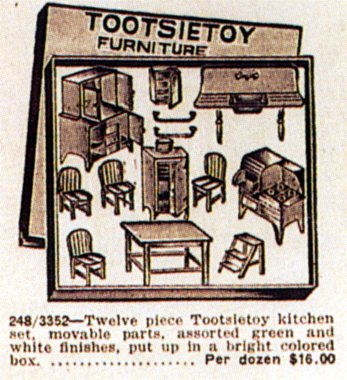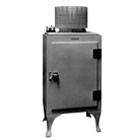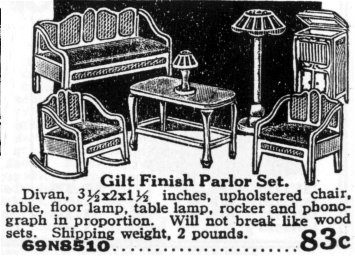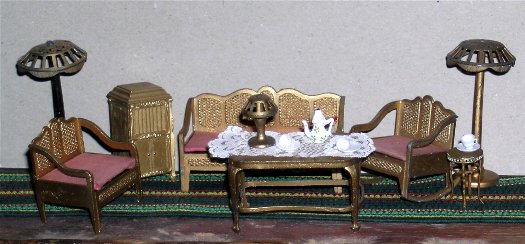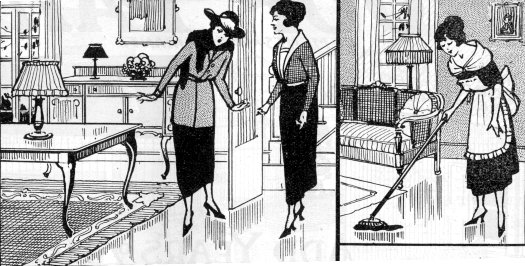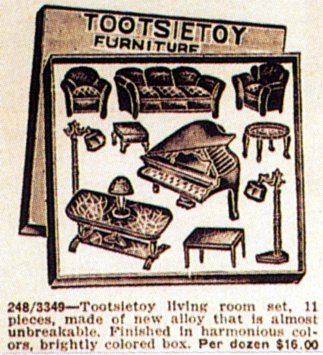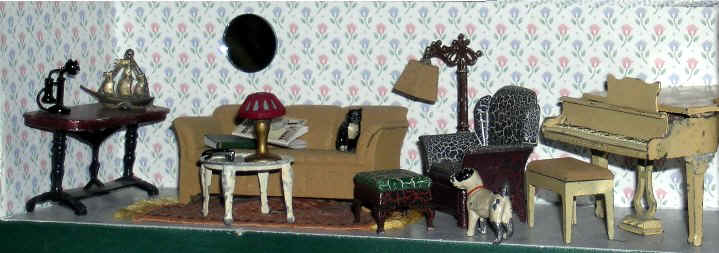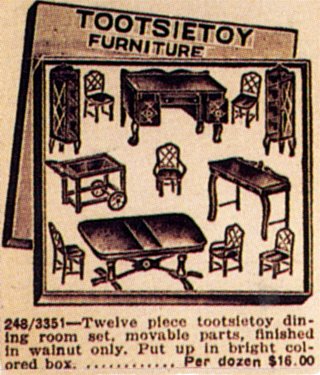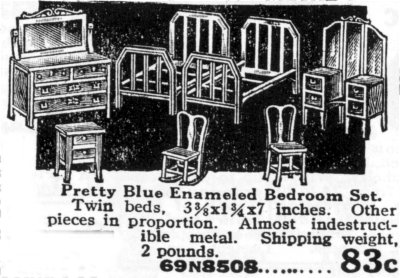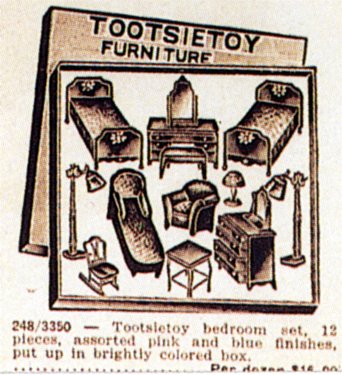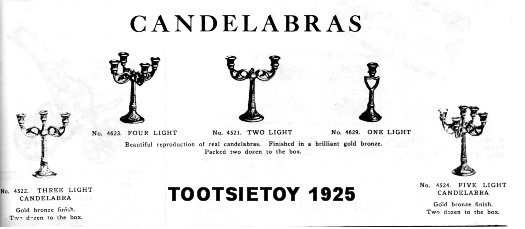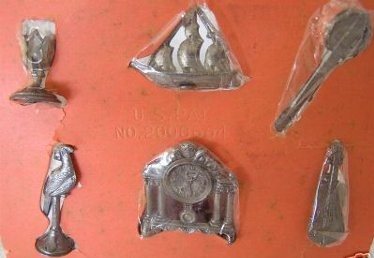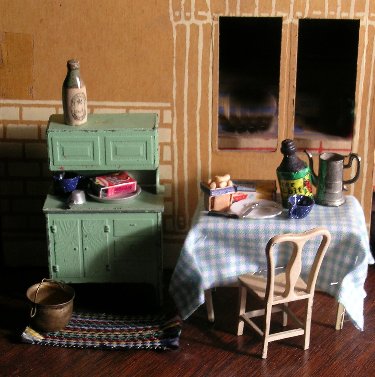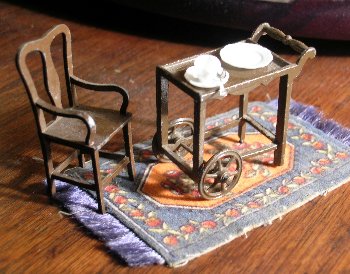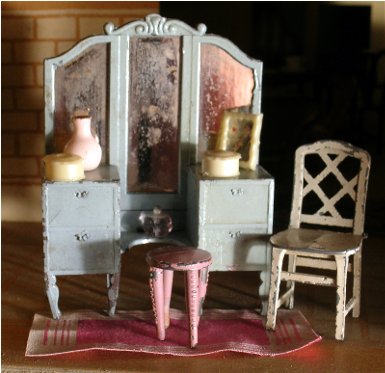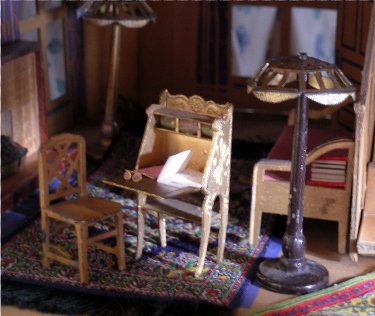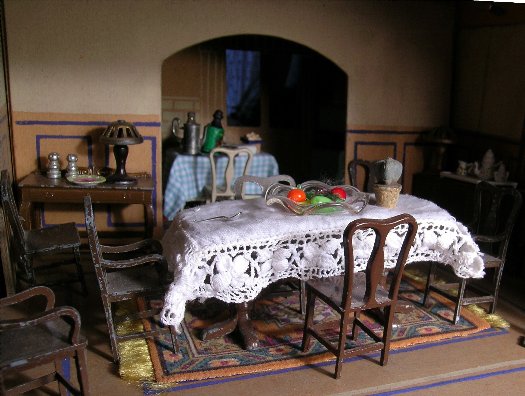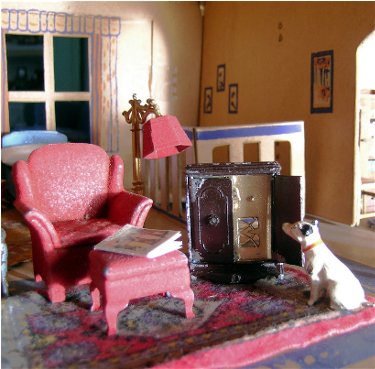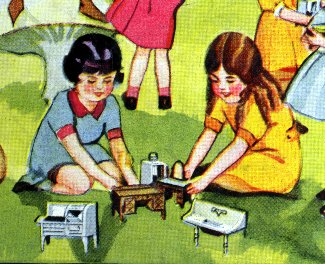home page 1890s 1900-1910 1910 to 1920 part 2: late 1920s part 1: 1930s part 2: 1930s 1940s 1950s part 1: 1960-1990 part 2: 1960-1990
Please see Part 2: late 1920s for Marx Newlyweds, Arcade, Hubley & Kilgore
The 1920s factory-made dollhouses saw the rise in popularity of printed cardboard versions, which were collapsible making it easy and cheap to ship to retailers or customers. Within this category, some were more elaborate than others, such as including printed interior features and using metal fastners to join parts rather than standard tabs. The problems with the latter were possible damage with use, as they projected at right angles to the main surfaces, and one side was printed but the other plain, making them visually disruptive. Today's collector hopes to obtain houses that were carefully packed away after initial use with all the parts present and in good shape. But, with today's technology, a missing piece, if it matches one that is present (such as one side of a four -sided chimney), can be duplicated by scanning 1:1, colour printing on paper, gluing the paper onto cardboard of the correct thickness, cutting out and positioning. Such replacements should be marked with the year in order to avoid future confusion about what is original.
The Dowst Brothers Company of Chicago cleverly allied their die cast (the product of casting from metal moulds) miniature furniture with various cardboard houses made by other companies. In this manner, little girls could obtain both house and furnishings in one mail order or purchase. Although manufacturing toys as giveaways and prizes (in Cracker Jack boxes) in earlier decades, their production of dollhouse furniture sets began soon after 1920 and continued until 1937. In the Sears, Roebuck and Co. catalogue of 1923 (below, close details are further below), for example, full sets of painted metal (an alloy of zinc and aluminum) furniture for the kitchen, bathroom, bedroom, dining room and parlour were offered at 83 cents each. Described as "Tootsie" (named after a family member who died tragically young at age 16 years), two years later it was "Tootsietoy." The promotional persuaders were that the pieces were made in a "special composition metal that will not break easily" and, further, that this "almost indestructible metal" would "not break like wood." Today's collector may challenge these claims, given the number of maimed pianos, table, sinks, etc. on the market, not to mention the chipped paint finishes. The scale is quite small, ½ inch to 1 inch.
By 1925, the "Tootsietoy Doll House" -- "a reproduction of a fine Colonial home" -- was available. It had appeared the previous year in the Sears, Roebuck and Co. catalogue (immediately below) and, although juxtaposed with Tootsie furniture, was not identified as their dollhouse. By itself, it sold for $3.79.
above: 1925 -- note on the left the demonstration of how the house is shipped and then assembled
The actual manufacturer (and who labeled the house as such along the foundation of one of the end walls) was Wayne Paper Goods Co., Ft. Wayne, Indiana. Made of "very substantial" painted container board and held in place by metal fasteners when assembled, the house was shipped in a box only ½ inch deep.
By 1928, when this ad (above) appeared in Sears Roebuck, the price of the house alone had plummeted from $3.79 in 1924 to $1.89, on special from $2.50 but, two years later, the regular price, post paid, was only $1.98.
Through wide archways at the rear of the main-floor dining room and upper-floor study or bedroom are the kitchen and bathroom, which can be accessed directly from a door that swings open on the rear of the house. Simple painted outlines on the interior walls and floors indicate paneling, pictures, curtains, tiling, linoleum (or floor tiles) and carpets. Some of the smaller rugs, positioned at an angle to the walls, correspond in size to tobacco premium carpets. The windows are cut out into four panes each and, after 1927 (probably one of the "new features" described verbally in 1927 and shown in an illustration the next year), there is a central staircase with a closet below. While the front wall (which opens via a pair of wide hinged sections) maintains the formal symmetry typical of American late 18th century houses and the late 19th century Colonial Revival style, the back wall shows a more casual appearance with a porch positioned asymmetrically to shelter the kitchen door and reminds one of contemporary houses.
There were other doll houses meant for Tootsietoy furniture:
Two-room bungalow in cardboard (right), 1928 Sears Roebuck catalogue.
Five-room bungalow in cardboard (left), Sears Roebuck catalogue, 1925
Six-room, two-storey cardboard house, some of which may be marked "No. 12 Tootsietoy Doll House ©1927 D.M. Co. Made in U.S.A."
Here (right) seen in Toy Town, Morton Converse & Son Co., Mass., catalogue of 1931 as the Realy Truly Doll House. What's more - it is shown filled with Realy Truly wooden furniture! (see part 2:1930s for this company)
The Tootsietoy Mansion of 1930 in book board was described as being designed by a real architect as a Spanish villa; real life prototypes were appearing at this time in journals such as Home Builders of 1928 (below left).
TOOTSIETOY FURNISHINGS
The first style of Tootsie bathroom fixtures in the early 1920s included a tub on feet, changed in 1930 to one representing a built-in tub with tiling on the exposed side and end (shown further down). The scales are inscribed: "Health-O-Meter."
Real plumbing
fixtures: the cast-iron tub on feet is from the 1911 Eaton's catalogue, Toronto, and the
above and left: 1920s bathroom
Below: 1920s Below 1930s
below: 1930s bathroom in orchid with cream accents; the "built-in" tub has "tiling" on the sides
The kitchens of the 1920s had fixtures with doors that did not open (left). The sink had a draining area only to one side.
Refrigeration
was still via an icebox, although the real
Kitchen sinks hanging on the wall and supported on legs in front were scorned in decorating guide books of the 1940s, by which time built-in sinks with counters and cupboards were standard. Right: a domestic scene from the James Robertson Co. Ltd catalogue, Montreal, no date [by 1920, when it was inscribed].
Below: 1920s
Below: 1930s
In the 1930s, the doors opened including a drop-down oven door (immediately above and left). The sink now had balancing draining areas. The green and white fridge had refrigeration coils on top -- electricity was now commonplace. It was only in 1927 that G.E. came out with its steel Monitor Top fridge (below).
The parlour set from the 1920s features delicate gilt furniture in imitation caning, reminiscent of the 'real life' domestic scenes in Halliday's catalogue of 1922, Hamilton, Ontario, Canada (second picture down). Electric lights are now in common use replacing or supplementing kerosene lamps and candles. These sets continued to be sold in the 1930s.
left and below: parlour set 1930s. In the 1930s, over stuffed couches, easy chairs and foot stools offered more casual and comfortable seating than the older caned sets. Marbelized coffee and parlour tables added to the "living room's" convenience as repositories of magazines and newspapers. Before the era of television, pianos were a source of amusement, especially as accompaniment for singing.
Below: 1920s Below 1930s
The dining set from the 1920s (left above) has a round table, while the 1930s table (right above) is rectangular and is accompanied by six lattice-back chairs and a pair of corner cupboards for china.
Below: 1920s Below: 1930s
The 1920s bedroom (left above) has openwork bed ends. The drawers do not open in the chest and dressing table. The 1930s beds (right above) have solid ends and the drawers open. The chaise lounge is an attractive addition.
Some Dowst furniture was also known as "My Dolly's Furniture" or "Daisy." Other pieces reminiscent in form to Dowst's 1920s products have been found marked "FRANCE." The following is a potpourri of Dowst products (and includes in the room settings some non-Dowst accessories):
Please see Part 2: late 1920s for Marx Newlyweds, Arcade, Hubley & Kilgor (all also producing in the 1930s).
Although Schoenhut & Tynietoy produced in the 1920s, they are discussed in part 2 of the 1930s section.
1890s 1900-1910 1910-1920 part 1: 1920s part 2: late 1920s
part 1: 1930s part 2: 1930s 1940s 1950s part 1: 1960-1990 part 2: 1960-1990
|
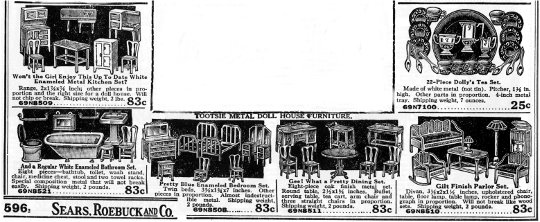
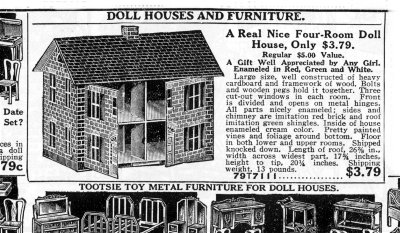
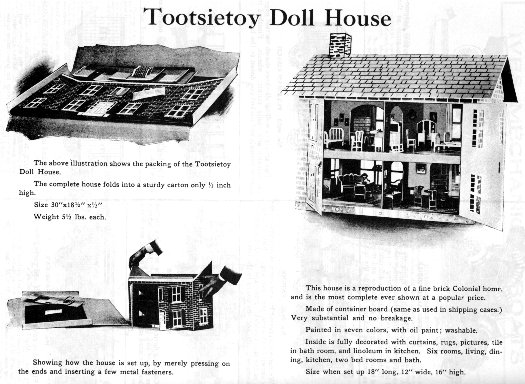
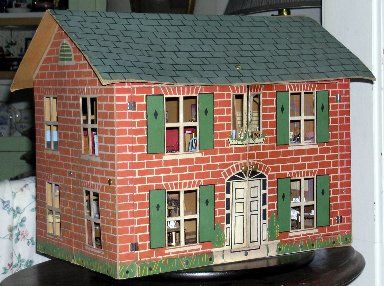
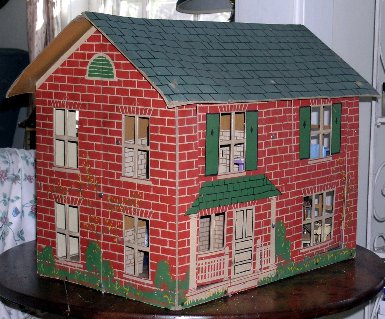
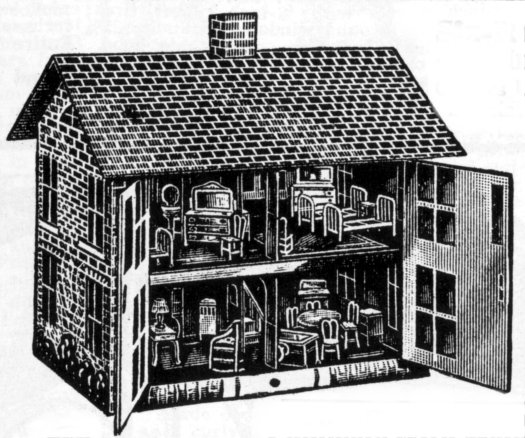
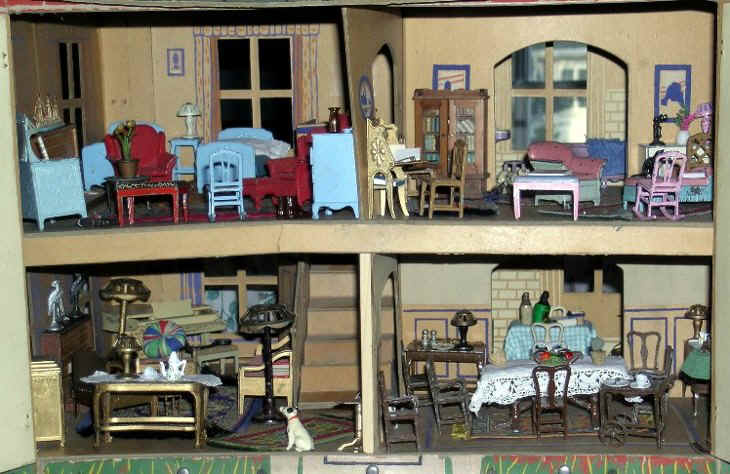
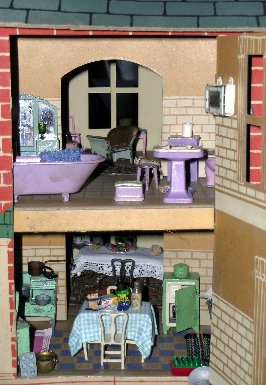
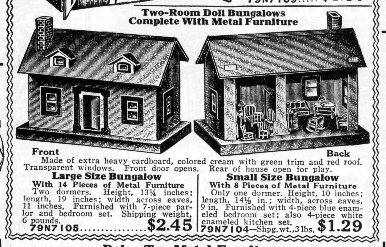
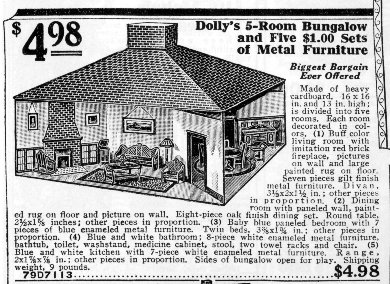
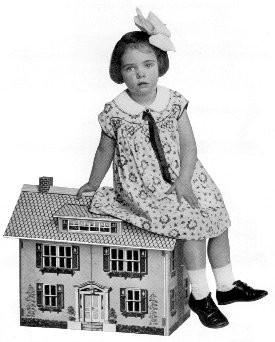

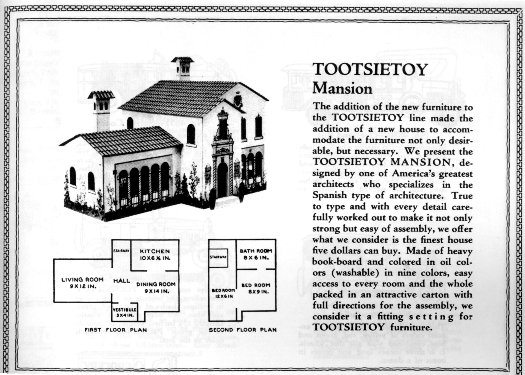
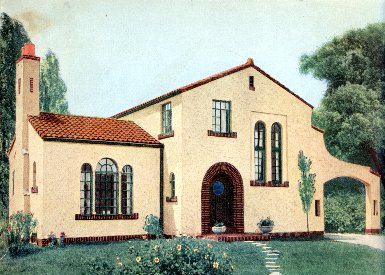
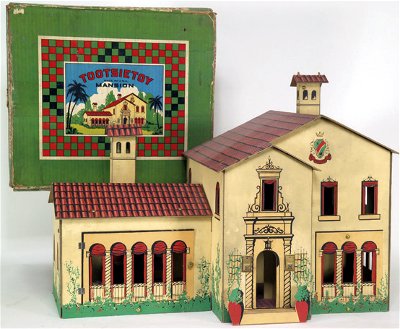

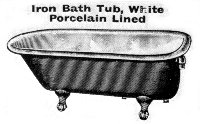 toilet with its tank hi
toilet with its tank hi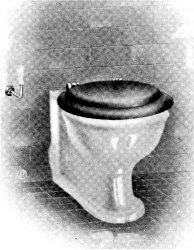 dden behind the wall is from the James
Robertson Co. Ltd catalogue, Montreal, no date [by 1920, when it was inscribed]
dden behind the wall is from the James
Robertson Co. Ltd catalogue, Montreal, no date [by 1920, when it was inscribed]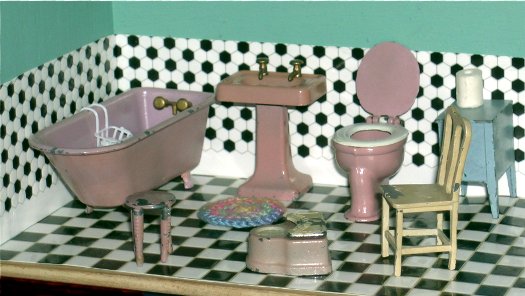
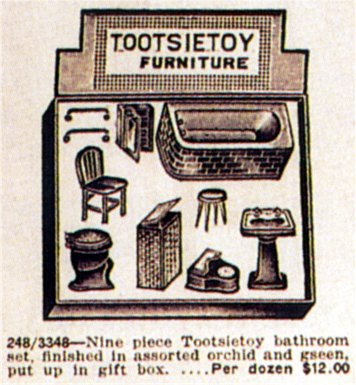
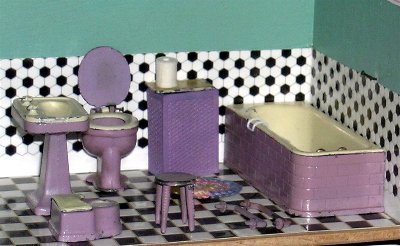
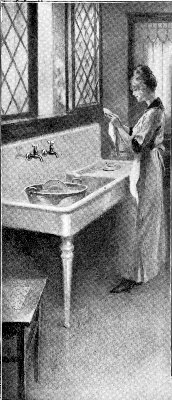
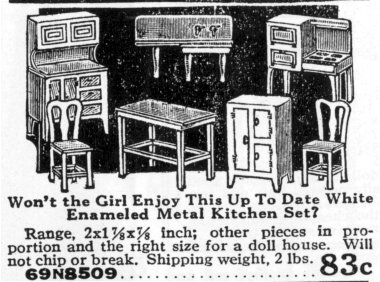
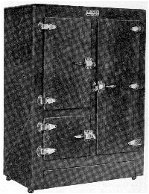 one shown here from 1928 (left, Home Builders Catalog) could be adapted for ice or
electricity.
one shown here from 1928 (left, Home Builders Catalog) could be adapted for ice or
electricity. 

